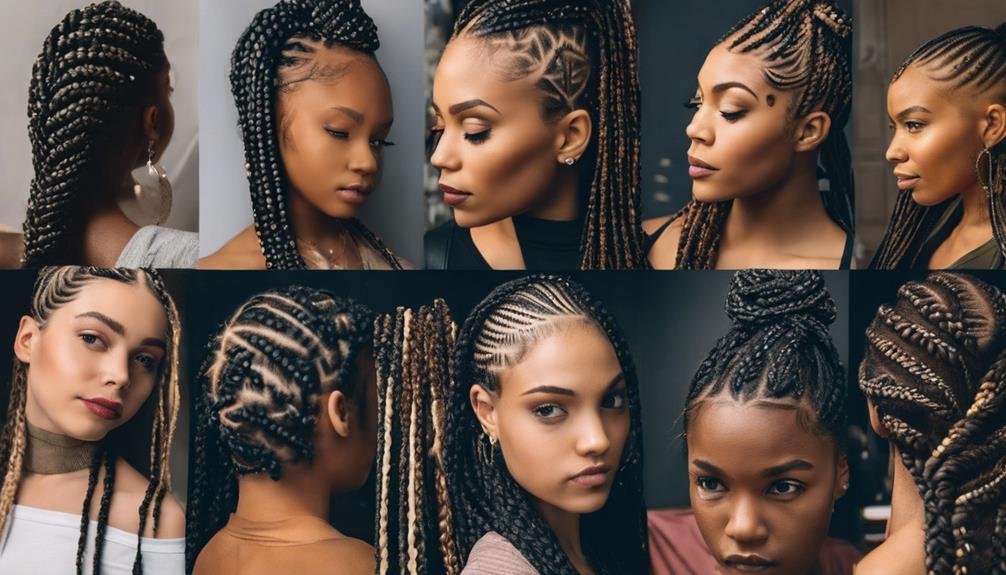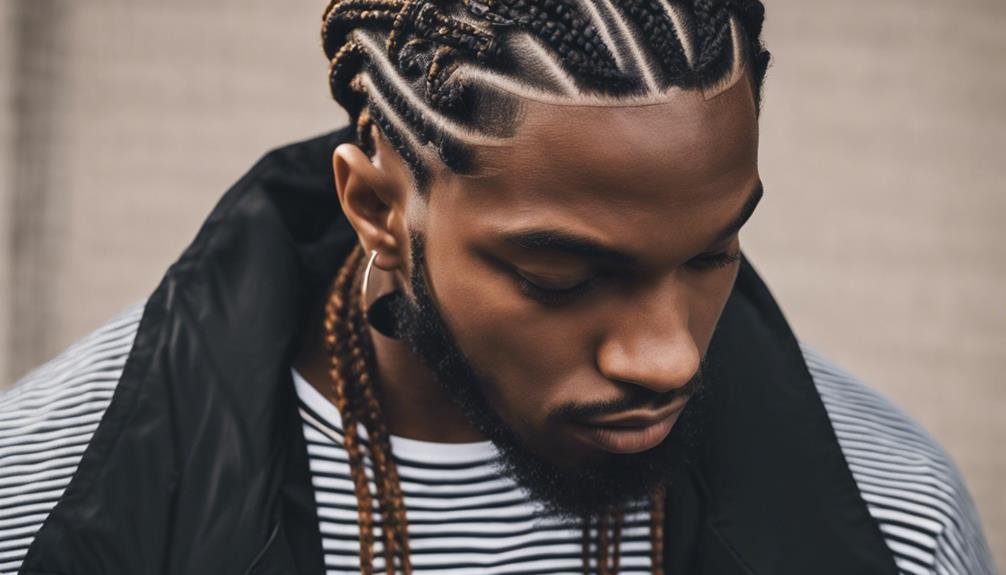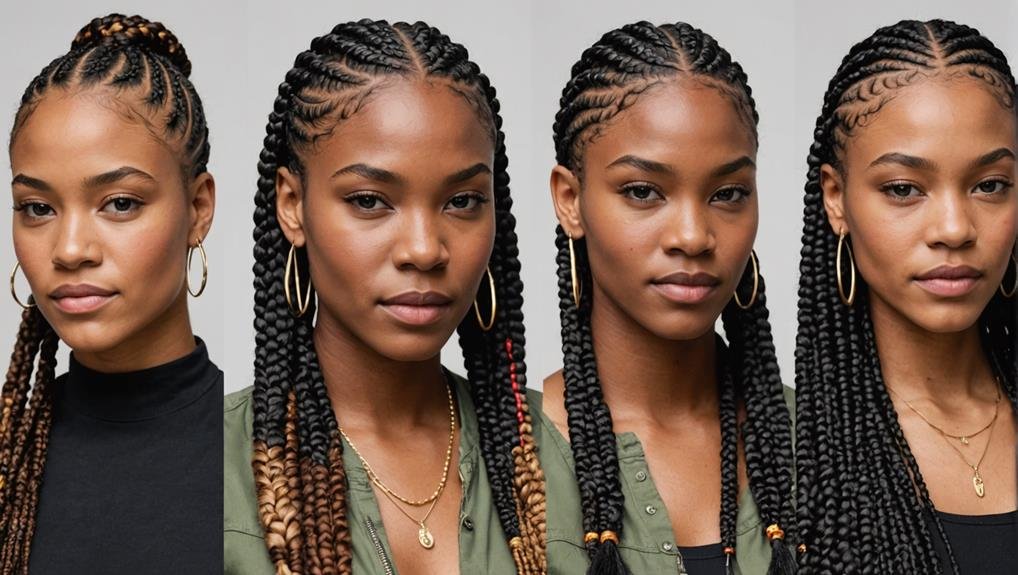Several factors come into play when deciding the right size for your cornrows. Hair length is a good starting point, as shorter hair might limit your options, whereas longer hair opens the door for more complex styles. Then there’s hair texture; finer hair might benefit from smaller cornrows for added versatility, but these can also increase tension on the scalp. Larger cornrows, on the other hand, offer a gentler touch. But how do you balance these choices with your personal style goals? Let’s explore what suits your unique needs.
Key Takeaways
- Consider hair length: 2 inches minimum for grip, 3-4 inches for versatility in cornrow designs.
- Match cornrow size to hair texture: small for fine hair, large for thick hair for scalp health.
- Smaller cornrows offer intricate designs; larger cornrows are quicker and gentler on the scalp.
- Men can opt for medium to large cornrows; blending sizes adds creativity.
- Consult a stylist to evaluate hair type and recommend appropriate cornrow size.
Understanding Hair Length

Understanding hair length is essential when choosing to style cornrows. You’ll want to start with at least 2 inches of hair, especially if you’re going for starter braids. This minimum length provides enough grip and stability to ensure your cornrows don’t unravel easily.
If your hair measures between 3 and 4 inches, you’re in a great spot for versatility in styling. This length is ideal for various cornrow designs, allowing you to experiment with patterns and intricacies.
Maintaining proper hair length can be challenging, particularly for shorter hair. It’s vital to keep your hair healthy and trimmed, as this supports the longevity of your cornrows. When your hair is at the recommended length, your braids can last longer, staying neat and secure.
Realize that your cornrows’ overall appearance and success heavily depend on having the right hair length.
Analyzing Hair Texture
Although hair length plays an important role in the success of your cornrows, analyzing hair texture is equally significant. Hair texture, which includes thickness and density, directly impacts cornrow size. If you’ve got fine or thin hair, opting for smaller cornrows can prevent hair breakage and keep your mane healthy. Smaller cornrows distribute tension more evenly across your scalp, reducing the risk of damage.
On the other hand, if your hair texture is thick or coarse, you can confidently go for larger cornrows. This choice enhances the boldness of your look and aligns with your hair’s natural strength and resilience. Larger cornrows can handle the weight and volume of thick hair without causing discomfort or unnecessary strain.
Matching cornrow size to your hair texture is vital for maintaining scalp health and ensuring your style lasts longer. A well-chosen cornrow size keeps your hair manageable and prevents issues like scalp irritation or premature unraveling. It’s always a good idea to consult a hairstylist who can evaluate your hair texture and recommend the ideal cornrow size. Their expertise ensures your cornrows look great and stay healthy.
Exploring Cornrow Styles

Consider how versatile designs can enhance your look and accommodate your hair length when exploring cornrow styles. Larger cornrows might offer less variety but reduce tension, while smaller ones provide more styling options at the cost of increased stress on your scalp.
Remember popular techniques like micro box braids or classic straightbacks to find a balance that suits your style and comfort.
Versatile Cornrow Designs
Cornrows offer versatility, from traditional straight-back styles to intricate geometric patterns that express personal flair. The beauty of cornrow designs lies in their aesthetic appeal and the variety of sizes available.
Whether you’re drawn to small, medium, or jumbo sizes, each offers unique benefits. For example, thinner cornrows allow for more creativity and flexibility in styling, perfect for weaving in intricate designs or combining with other styles. On the other hand, larger cornrows can be braided faster, making them a great option if you’re short on time.
When deciding on your ideal cornrow size, consider how the size will impact the look and longevity of the style. Smaller cornrows typically last longer due to their tightness and intricacy, while larger ones might need more frequent touch-ups.
Consult with a stylist who can guide you based on your hair texture, length, and the look you’re aiming for. They can help you balance your desired cornrow design and the practical aspects of maintaining your chosen style. Remember, the right size can significantly enhance your cornrow experience.
Hair Length Considerations
Choosing the right cornrow size is just one part of the equation; your hair length is equally crucial in achieving the perfect style. Understanding how your hair’s length can impact the outcome is vital when considering braids. Hair length ranging from 2 to 4 inches is typically suitable for various cornrow styles. This length offers enough flexibility to create neat, intricate designs while keeping the braids securely in place.
If you aim for more intricate patterns, longer hair might be necessary to achieve the desired versatility. Complex designs often require extra length to ensure the braids hold securely and look distinctive.
However, if your hair is shorter, there’s no need to worry. You can still rock cornrows with starter braids, which can help your hair grow while maintaining a stylish look.
It’s advisable to consult with a hairstylist to determine the ideal hair length for your specific style aspirations. They can offer personalized advice based on your hair type and growth patterns. Additionally, exploring videos on social media platforms like TikTok can give you a visual sense of the recommended hair lengths for various cornrow styles.
Popular Styling Techniques
Plunge into popular cornrow styling techniques, where creativity meets tradition. Whether you’re exploring stitch braids, knotless braids, or faux locs, each style offers a unique look and texture. For men, #cornrowstutorials can be especially helpful when styling short hair. Stitch braids are an excellent choice for #braidsonshorthair, providing a neat and stylish appearance.
Traditional cornrows also work well for a classic yet practical look, making them a popular option for #mensbraids.
When it comes to unique designs, the possibilities are endless. Singles, plaits, and twists are just a few of the braid designs you can consider to personalize your cornrow style. These options allow you to tailor your look to your preferences and hair type.
Many hairstylists specialize in specific braid types, so it’s worth finding someone who can bring your vision to life. Instagram is a great resource, with countless hairstylists showcasing their work and offering inspiration for your next cornrow adventure.
Small Vs. Large Cornrows
When considering cornrow size, you must consider tension and hairline health. Small cornrows offer more styling and versatility but can exert more pressure on your scalp if not done carefully.
On the other hand, large cornrows are easier on your hairline and quicker to install, though they might limit your styling options.
Tension and Hairline Health
Balancing the tension on your hairline is vital when deciding between small and large cornrows. Small cornrows often create more tension, stressing your hairline and potentially leading to issues like traction alopecia. This tension can compromise hairline health, especially if your hair is thinner.
On the other hand, large cornrows are typically gentler on the scalp and hair follicles, offering a healthier option if you’re concerned about maintaining a robust hairline.
Scalp health is pivotal. If you have to sensitize for larger cornrows, it might be your best bet if you have skin or a delicate hair texture, opting for large pressure more evenly across your scalp, reducing the risk of damage.
While smaller cornrows may look more intricate, they pull more at the roots, which could lead to hair breakage or loss over time.
Always factor in your hair texture and thickness. Thick hair might handle smaller cornrows with less strain, but if your hair is fine, you’re better off with larger ones. Prioritizing comfort and long-term hair health will guide you in choosing the right size for your cornrows.
Styling and Versatility Options
Exploring cornrows’ styling and versatility options reveals distinct advantages for small and large sizes. Small cornrows are your best bet if you’re after intricate designs and patterns. Their smaller size allows for detailed styles that can showcase your creativity. These cornrows are perfect for experimenting with complex hairstyles that make a statement. However, they require more time and precision during installation, so patience is key.
On the other hand, large cornrows offer a different set of benefits. They’re ideal if you prefer a quicker styling since they cover more area with fewer braids. This size also applies less tension on your scalp, which might be more comfortable if you’re concerned about hairline health. Large cornrows can look chic with the right accessories and maintenance.
Consider your hair length and desired look when deciding between small and large cornrows. Discuss the pros and cons of each size with your hairstylist. They’ll help you choose the best option for your hair type and personal style preferences, ensuring you achieve your desired look.
Men’s Cornrow Preferences

Men often opt for medium—to large-sized cornrows, aiming for a bold and masculine look. Consider these sizes if you want to make a strong statement with your hairstyle. Larger cornrows can give you a rugged, powerful appearance, perfect for standing out.
However, don’t dismiss smaller cornrow sizes; they are also gaining popularity among men. They offer a more intricate and detailed style, adding an artistic flair to your men’s braids.
Your choice could depend heavily on hair texture and length, but it’s also about how much maintenance you’re willing to commit to. Larger braids can be easier to upkeep, while smaller ones might require more attention. Yet, blending different sizes can add creativity and dimension to your style. A cornrow tutorial can provide insights and inspiration for these mixed sizes, allowing you to express your unique personality through your hair.
When choosing your cornrow size, consider:
- Expressing your individuality: Make a statement that’s uniquely yours.
- Balancing style and upkeep: Decide what’s manageable for you.
- Exploring creativity: Mix sizes for a dynamic look.
- Embracing versatility: Adapt your style to different occasions.
- Feeling confident: Rock a look that makes you feel great.
Challenges With Hair Length
When it comes to styling cornrows, dealing with hair length can sometimes present its own set of challenges. Maintaining the right hair length is essential, especially if you’re aiming for intricate cornrow styles. Longer hair often allows for more elaborate designs, while shorter hair might limit your options. You might find that certain styles require a minimum length to look their best.
Short hair can be particularly tricky, as it may demand specific techniques to guarantee durability. You might need to rely on special gripping methods during braiding so your cornrows don’t unravel quickly. Here’s a quick overview to visualize these challenges:
| Hair Length | Challenges |
|---|---|
| Long | Easier for intricate designs |
| Medium | Versatile but may require smoothing |
| Short | Limited styles need a strong grip |
| Varying Length | Difficult to grip, affect the outcome |
Each length presents its own set of hurdles. Knowing the best size for your desired cornrow style can make a significant difference. Some hairstylists even have specific preferences for the hair lengths they work with, ensuring they achieve the best possible outcome for your cornrow style.
Consulting With a Stylist

Some might be unsure about the right size of cornrows for their hair, but consulting with a stylist can offer clarity and direction. When you consult a stylist, they can evaluate your hair length and texture, ensuring you get cornrows that complement your features. By discussing your styling preferences and hair care routine, the stylist can help you find a style that fits your lifestyle and personal taste.
A stylist can provide invaluable insights into the pros and cons of different cornrow sizes. For instance, smaller cornrows might offer more styling versatility but can place more tension on the scalp. Larger cornrows might be easier on your scalp but require more maintenance. Understanding these nuances helps you make an informed decision.
Consider these emotions when deciding whether to consult with a stylist:
- Relief: Knowing your hair is in expert hands.
- Confidence: Trusting that your cornrows will suit your hair length perfectly.
- Excitement: Discovering new styling possibilities.
- Peace of mind: Receiving personalized care recommendations.
- Empowerment: Making a choice that truly reflects your personality.
Conclusion
Consider your hair’s length, texture, and style preferences to choose the right cornrow size. You’re off to a good start if your hair is at least 2 inches long. Smaller cornrows work well for thin hair but can be harsh on the scalp, while larger ones are gentler and faster to style. Don’t hesitate to consult a stylist for personalized advice. Ultimately, your comfort and desired look should guide your decision.
FAQs
What factors should I consider when choosing the size of cornrows?
When choosing the size of cornrows, consider your hair thickness, length, and the style you want to achieve. Thicker hair may support larger cornrows, while thinner hair might look better with smaller cornrows. Also, think about the level of maintenance you’re comfortable with, as smaller cornrows can require more upkeep.
Key Points:
- Consider hair thickness and length
- Choose a size based on the desired style
- Smaller cornrows need more maintenance
What are the differences between small, medium, and large cornrows?
Small cornrows are more intricate and time-consuming but provide a sleek and neat look. Medium cornrows balance intricate design with easier maintenance. Large cornrows are quicker to install and offer a bold, statement look but may not last as long as smaller sizes.
Key Points:
- Small cornrows: Sleek, detailed, higher maintenance
- Medium cornrows: Balance of style and maintenance
- Large cornrows: Bold, quick to install, less longevity
How do I maintain different sizes of cornrows?
Smaller cornrows may need more frequent touch-ups as they can unravel or frizz quickly. Medium and large cornrows are generally easier to maintain but might require extra care to prevent loosening, especially around the edges. Protect your cornrows at night with a silk or satin scarf to reduce friction.
Key Points:
- Small cornrows: More frequent touch-ups
- Medium/large: Easier maintenance, fewer touch-ups
- Use a silk/satin scarf to protect yourself at night

